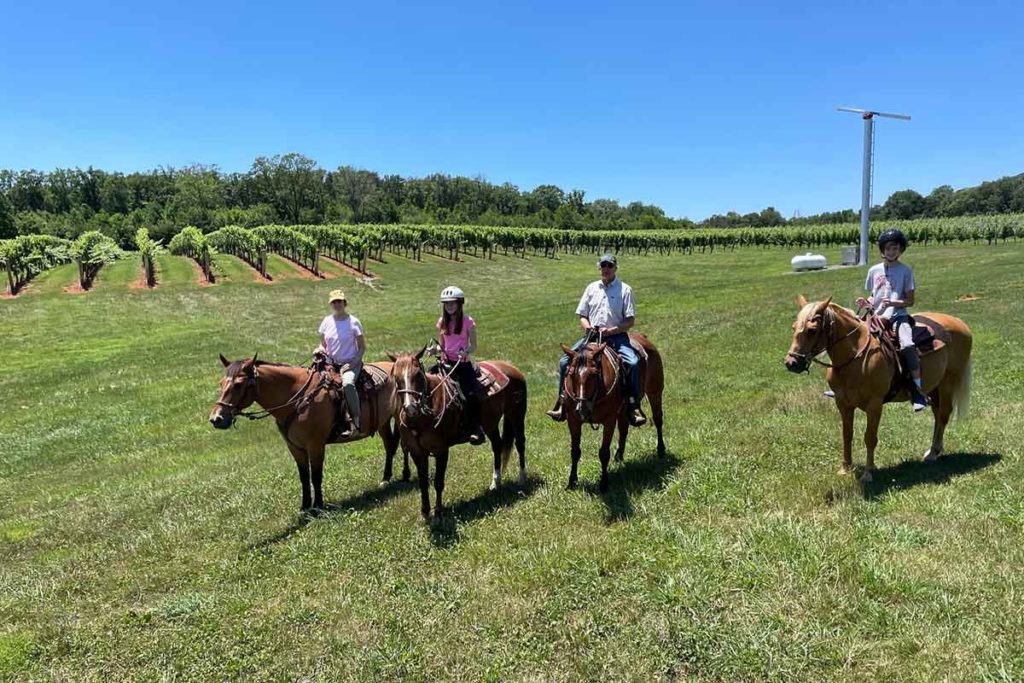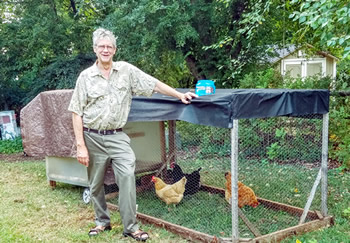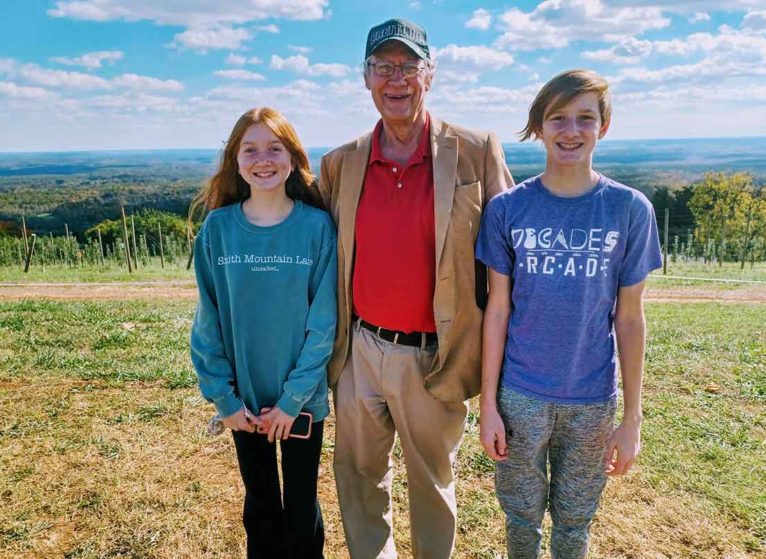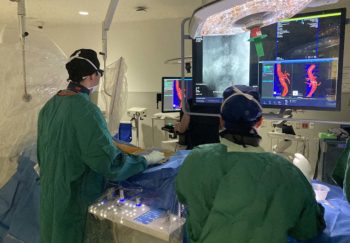We originally told this story in 2016. It seemed about time to check in with Norm, who survived a massive aortic aneurysm that year, to see how he was doing.
Still Grateful After All These Years
"Last October, I sat on my porch and it was a beautiful day. And I am still alive." Norm tells me. "It's been 7 years, and I'm still here." He's talking about the massive aortic aneurysms he suffered in 2016. At the time, Norm's heart was weak from congestive heart failure. Not every heart specialist has the expertise for this kind of situation. So UVA Health surgeons stepped in to perform what was a very dangerous surgery.
The big things are meaningless. The important things are the small things.
Norm Ratesic
So grateful for his life saved, Norm wrote to his surgeon, thanking him and the whole team for what they did.
No, he's not the picture of health. Norm explains that "the insides are a little worn down. I have 5 different doctors. I had 7 doctor's appointments in February. I take 4 medications every day." But there's not an ounce of self-pity or complaint in his tone.
Instead, Norm's gravely voice conveys a humble wonder. He's proud that, since the operation, he hiked a small part of the Appalachian Trail. He's happy that kicking his daily cola habit helped him lose 5 lbs without trying. And when a neighbor misjudged him as much younger the other week, Norm soaked up the praise.

When asked how he's taken care of himself, he says, "I watch what I eat, lots of fruits and veggies, I walk almost every day, I listen to the doctors. I keep breathing." And of course, the UVA Heart and Vascular teams that keep up with Norm have left him "very pleased. Even during the pandemic, everything goes so smooth, there's a flow to the whole system."
But what Norm prizes above all else is that his daughter asked him to teach his granddaughter how to drive.
"I was so touched Heather Rose trusted me. I am so pleased to teach Caroline how to drive. I just hope I live long enough to do the same thing with my grandson, Lennon. Riding with my granddaughter is really a treat."
Norm tells me more than once that it's this kind of "small" experience that makes him grateful for every day he's here.
"People don't realize how big that feels. Just being alive," he says. "It's hard to make anyone understand. The big things are meaningless. The important things are the small things."
Surviving a Burst Aortic Aneurysm
The original 2016 story.
Norm Ratesic is my neighbor, and he's a kind one. He tolerates our dog eating the cat food he keeps on his front porch; he invites my kids to pick the sour cherries from his tree; he shares his chicken’s fresh eggs. Sometimes he pretends to be a bit crusty and gruff, but no one is fooled: Norm is the type of generous soul you can’t help but like and trust.

Norm, in his mid-60s, has never been a health nut. But he’s always done his yearly physical, and a couple years ago when he went, everything — blood pressure, cholesterol, etc. — looked fine.
“Then I woke up one night. And I couldn’t breathe. Vivian wanted me to go to hospital. Then the doctor wanted me to go to hospital.” Norm was reluctant, but he went to a nearby hospital. And they discovered, “My blood pressure was out of control, out of nowhere. It had been perfectly fine. Then bam!”
A Drastic Diagnosis
The thing was, Norm wasn’t in any pain. “I felt like I ate too much turkey. No pain, just discomfort.” This didn’t seem like a big deal. Still, he underwent the recommended tests.
The diagnosis? Congestive heart failure. But that wasn’t all. “They found I had a large aneurysm on an artery — (a large thoracoabdominal aortic aneurysm (TAAA)). And a second one in my pelvis, too. But they couldn’t operate on it because my heart was not strong enough to withstand the operation.”
Or at least, that’s what they thought at first. And it was a conundrum. An aneurysm occurs when your blood vessel walls get so weak they bulge out; too much bulging, and the walls can burst. A burst aneurysm causes bleeding that is not just dangerous, but fatal. Without treatment, Norm was like a walking time bomb.
There was discussion of stents, defibrillators, other options — the crisis went beyond their expertise.
Aneurysm Risk?
See UVA Health experts right away
A Second Opinion at UVA
So Norm went to UVA, where the surgeons offered new hope.
“While he did have heart failure, we felt open surgery was his best option,” says Gilbert R. Upchurch Jr., MD, one of Norm’s surgeons.
“They came to me and said they thought my heart was strong enough,” Norm says. “So they asked: When do you want to have the operation on your aneurysm? October 1st or 15th?”
Norm, wanting to get the whole thing over with, chose the 1st.
“And it’s a good thing, too,” he says. “I wouldn’t have made it until the 15th.”
The Just-In-Time Miracle
As Upchurch explains, a TAAA operation is not only “life-threatening, but also can run the risk of a patient being paralyzed and put on dialysis.”
About Upchurch, Norm remembers, “He’s a very upbeat type of doctor. I remember him telling me how painful this would be, how horrible of an operation it was, even before they discovered the aortic aneurysm had burst. He was being frank. He also told me about the risk factors of not surviving, the 5 percent mortality rate, even with good health. A whole bunch of percentages that weren’t good. They were saying I might have five minutes of life or five years. My son is disabled. He asked me to stay for him as long as I could.”
When Upchurch and John A. Kern, MD, opened Norm up to repair the TAAA, they discovered that the aneurysm had, in Norm’s words, “blown apart.”
"I should have bled to death in under 3 minutes. But it clotted against my spine.”
This was already an intense procedure; the situation was now even more precarious. “They collapsed my lung, stopped my heart. It took 14 hours and a 19-inch incision. They took videos to show their students; they hadn’t seen one like that at UVA — because you don’t usually live.”
One surgeon told Norm later, “’When we opened you up, it looked like you’d been hit by a truck.’ I could tell she was saying it like, ‘How are you alive?’”
Norm didn’t know. To him, the fact that the UVA surgeons caught his aneurysm before he died feels like a miracle.
Tough Recovery: Moving to Live
Getting through the post-operation period proved less miraculous. Everything was painful.
At one point, Norm remembers almost giving up. “I was immobile and in pain. I couldn’t hardly move. I gave up for a few minutes, it was so unbelievably bad. I stopped breathing. This nurse started yelling at me to breathe, and it worked. She knew I was giving up and tried to make me fight, and she succeeded.”
After the operation, “the first time I walked, the nurses were very enthusiastic about how far I walked to get out of the room. They expected me to call it a day. But I focused on the nurses’ station and inch by inch I got up there. I turned around and came all the way back into the room. They were saying, ‘Wow! Unbelievable! Fantastic! You’re so determined!’ I was dripping with sweat and hurting like crazy. I wanted a beer, but I settled for an ice cream.”
Norm shakes his head. “I look back, and I have no idea at all how I did it. I can only remember how much it hurt, shaking fearfully as I took my first few steps. No idea where I got the strength from. Friends, priests, prayers? I wish I knew. Clearly, it’s true: if you move, you live. They told everyone I’d be in there for 14 days; they kicked me out on the 8th day. I didn’t need the 2-3 weeks of rehab they said I’d have to have. I’m not superman. I’m not bragging. Instinctively, I knew I had to move.”
For the second aneurysm, a less-invasive technique was an option, so the surgery was much easier. “It went the best way possible,” Norm says.
Upchurch agrees. “He did great; we were able to repair his common iliac artery aneurysm using an endovascular method, with a stent-graft. He has done well from these surgeries. He suffered really no major complications and remains well.” Doctors customize stent-grafts and then insert them into an artery through a patient’s groin, a procedure that results in shorter recovery times and less scarring than occur with open surgery.
Norm’s prognosis is good. “I was fortunate as I wasn’t overweight and in fairly good shape. Based on what they could tell, I have as much chance as anyone to live to 85.”
And Norm is grateful. “I still tire. But I walk, I work, I get out, and do the best I can. If I die tomorrow, it was all worth it; I’ve spent more time with my son and grandchildren. Every day is a beautiful day.”



Just out of curiosity, was the feeling of fullness due to the congestive heart failure or the thoracoabdominal aortic aneurysm?
On June 10th of this year I had a aortic aneurysm burst while walking across the floor, it felt like a balloon had burst in my abdomen. There was severe pain so I called 911 before I passed out, I remember being put in a helicopter and then passed out again, I woke up a month later as I had been put in a drug induced coma. It turns out I had to have 3 surgeries in the first 2 days. I credit the doctors and nurses in mendota Illinois and Rockford Illinois with saving my life but I am only 4 months out from the event and I still have a lot of pain, I have read that the life expectancy of someone whose aortic aneurysm had burst is not long however I am hoping that my doctors can extend my life i am 56 and hoping to have more time to spend with my grandkids